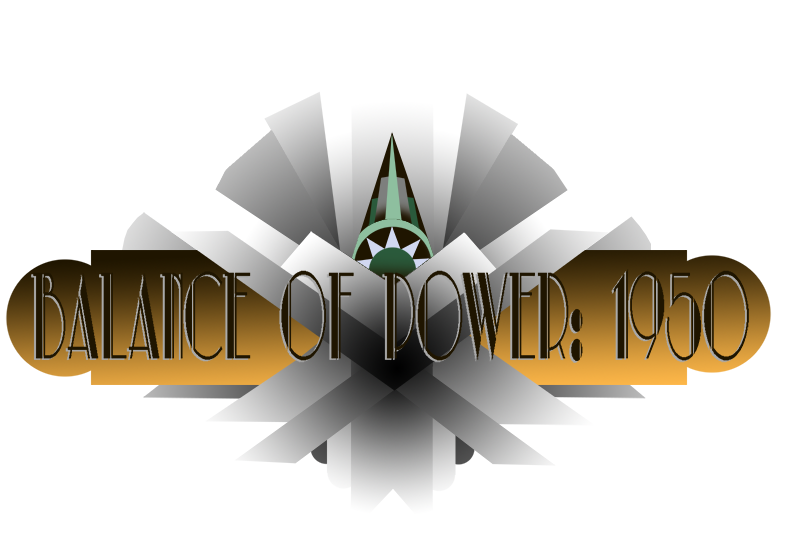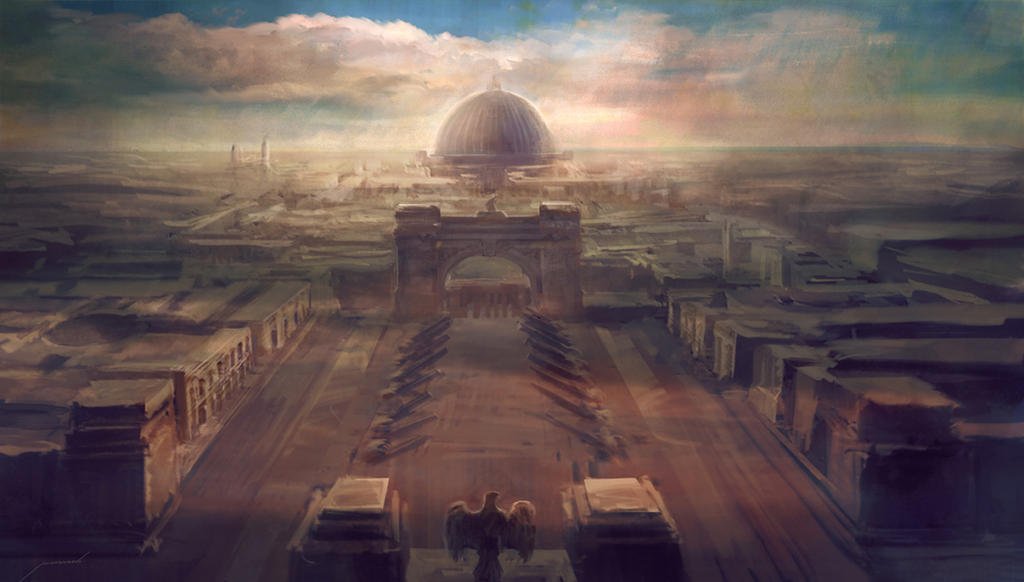With no further ado, as your host, I proudly present to you...
First, I'd like to extend my ardent gratitude to Hulksmash, for his determined efforts in bringing the map to its completion, to my wife, for her wonderful work in creating original artwork and headers for the OP, as well as her unabating patience while I worked on the BoP, and to you, the players, for your patience in sticking through to the much delayed release. And a special thanks to Jhessail, Epicrules, Pixel, and Eternal for their help and consultation on background research, balancing concerns, and the process of running a BoP, I wouldn't have gotten off the ground without their help!
The Original File, open in another tab/window
http://i689.photobucket.com/albums/vv259/Tiberius_Maximus/TDMexp15_zps3uao5a9j.png~original
The year is 1950. Today marks the 5th anniversary of the end to the most destructive war in the history of civilization. Five years ago to the day, the world changed forever in the glare of nuclear fire, first on VR Day (Victory over Russia), followed by the final conclusion of large scale combat after VA Day (Victory over America). What has resulted is the emergence of a new order, almost unrecognizable from where the world stood in 1939 as the Second World War began: for the Axis won the war. This is a new world, of crumbling European Empires replaced by new hegemons of ideology, one of nuclear weapons and jet power, and of proxy wars and power blocs formed from the competition of once staunch allies. Today we remember the past, commemorating either with celebration and victory parades and toasts of triumph, or marking the last days of defeat and of shattered nations, but all recall the lives lost in the dark days of the World Wars. And perhaps, take them as portent of the lives yet to be lost in the wars to come, their origins ignited even as the last war ended. But all of us look to the gleaming chrome future in this new world, and for some, to the stars beyond.
Welcome to BoP: 1950! The Balance of Power: 1950 game is set in a world very similar to ours as it stood in the 1950s, and yet so radically different. Our world is one where the worst has come to pass: the Axis has won the Second World War. And yet, the world lives and attempts to move on. The game is, beyond its alternate-history setting, best described as semi-historical, borrowing a number of elements from diesel/decopunk as well as references to classic film and media (as well as some more recent inspirations). But it is a world of competition, and this plays out in many fronts beyond the battlefield, as nations and empires compete for ideological supremacy, hone the cutting edge of technology (discovering technologies even beyond the achievements of the real world), and ultimately look skywards to spread their influence beyond the Earth.
As things stand at the beginning of the game, the new players aside, in terms of technology and culture the world is roughly similar to where it stood in our version of history, though without the diffusion of German military technology through Operation Paperclip and parallel Soviet looting of patents and prototypes, there is a greater reliance on wartime models for armor, aircraft, and weapons. However, the course of technology, and ultimately history, is in the hands of the players, and with the alternate history setting I'm quite willing to blur the line between reality and fiction, so if you wish to bring into the world ideas from Fallout, or Wolfenstein, or even the real if implausible prototypes and designs that were the result of World War 2 ambitions and Cold War research, be my guest. Whether they are successful, or beyond that, practical, is dependent on your funding allocation and my own whims, but the point is that the tech tree is a general guideline, and custom, special military units are yours to create. This is an exciting time for science and technology: I encourage you to push its limits and above all enjoy yourselves!
1. Keep discussions on-topic and reasonable.
2. Don't miss deadlines. You applied for this game, showing your willingness to participate. Now don't disappoint.
3. You may not directly quote, screenshot, or copy and paste any parts of a country card, turn report, or private conversation with the host or another player into the thread. You are also heavily discouraged from doing this in private conversations.
4. You may not edit or delete posts in this thread. The first time, you will be warned. Each violation after that will result in a penalty enacted on your nation in game.
5. If you like, add me into your private conversations. I enjoy reading them.
6. Credit amounts are both relative and absolute. Domestic credit spending is relative and proportional to country size, whereas international (military and espionage, for example) spending and effectiveness is absolute.
Major Powers:
America (Superpower): Benno Maximus [Democracy]
Germany (Superpower): Mahud [Fascist]
India: Grimmend [Democracy]
Italy: Arcadius [Fascist]
Japan (Superpower): Gaham [Fascist]
Soviet Union: Blacktide [Communist]
Regional Powers:
Brazil: Jhnking [Non-Aligned]
Canada (And the Free British Commonwealth in Exile): Odysseus [Democracy]
Imperial Government of Great Britain: Amontadillo [Fascist]
Persia: Stark99 [Non-Aligned]
Saudi Arabia: Eternal [Non-Aligned]
Siam: AndHisName [Fascist]
Turkey: AdmiralThrawn [Non-Aligned]
French State: Epicrules [Fascist]
Spain: Pixel [Non-Aligned]
First, I'd like to extend my ardent gratitude to Hulksmash, for his determined efforts in bringing the map to its completion, to my wife, for her wonderful work in creating original artwork and headers for the OP, as well as her unabating patience while I worked on the BoP, and to you, the players, for your patience in sticking through to the much delayed release. And a special thanks to Jhessail, Epicrules, Pixel, and Eternal for their help and consultation on background research, balancing concerns, and the process of running a BoP, I wouldn't have gotten off the ground without their help!
The Original File, open in another tab/window
http://i689.photobucket.com/albums/vv259/Tiberius_Maximus/TDMexp15_zps3uao5a9j.png~original
The year is 1950. Today marks the 5th anniversary of the end to the most destructive war in the history of civilization. Five years ago to the day, the world changed forever in the glare of nuclear fire, first on VR Day (Victory over Russia), followed by the final conclusion of large scale combat after VA Day (Victory over America). What has resulted is the emergence of a new order, almost unrecognizable from where the world stood in 1939 as the Second World War began: for the Axis won the war. This is a new world, of crumbling European Empires replaced by new hegemons of ideology, one of nuclear weapons and jet power, and of proxy wars and power blocs formed from the competition of once staunch allies. Today we remember the past, commemorating either with celebration and victory parades and toasts of triumph, or marking the last days of defeat and of shattered nations, but all recall the lives lost in the dark days of the World Wars. And perhaps, take them as portent of the lives yet to be lost in the wars to come, their origins ignited even as the last war ended. But all of us look to the gleaming chrome future in this new world, and for some, to the stars beyond.
Welcome to BoP: 1950! The Balance of Power: 1950 game is set in a world very similar to ours as it stood in the 1950s, and yet so radically different. Our world is one where the worst has come to pass: the Axis has won the Second World War. And yet, the world lives and attempts to move on. The game is, beyond its alternate-history setting, best described as semi-historical, borrowing a number of elements from diesel/decopunk as well as references to classic film and media (as well as some more recent inspirations). But it is a world of competition, and this plays out in many fronts beyond the battlefield, as nations and empires compete for ideological supremacy, hone the cutting edge of technology (discovering technologies even beyond the achievements of the real world), and ultimately look skywards to spread their influence beyond the Earth.
As things stand at the beginning of the game, the new players aside, in terms of technology and culture the world is roughly similar to where it stood in our version of history, though without the diffusion of German military technology through Operation Paperclip and parallel Soviet looting of patents and prototypes, there is a greater reliance on wartime models for armor, aircraft, and weapons. However, the course of technology, and ultimately history, is in the hands of the players, and with the alternate history setting I'm quite willing to blur the line between reality and fiction, so if you wish to bring into the world ideas from Fallout, or Wolfenstein, or even the real if implausible prototypes and designs that were the result of World War 2 ambitions and Cold War research, be my guest. Whether they are successful, or beyond that, practical, is dependent on your funding allocation and my own whims, but the point is that the tech tree is a general guideline, and custom, special military units are yours to create. This is an exciting time for science and technology: I encourage you to push its limits and above all enjoy yourselves!
1. Keep discussions on-topic and reasonable.
2. Don't miss deadlines. You applied for this game, showing your willingness to participate. Now don't disappoint.
3. You may not directly quote, screenshot, or copy and paste any parts of a country card, turn report, or private conversation with the host or another player into the thread. You are also heavily discouraged from doing this in private conversations.
4. You may not edit or delete posts in this thread. The first time, you will be warned. Each violation after that will result in a penalty enacted on your nation in game.
5. If you like, add me into your private conversations. I enjoy reading them.
6. Credit amounts are both relative and absolute. Domestic credit spending is relative and proportional to country size, whereas international (military and espionage, for example) spending and effectiveness is absolute.
Major Powers:
America (Superpower): Benno Maximus [Democracy]
Germany (Superpower): Mahud [Fascist]
India: Grimmend [Democracy]
Italy: Arcadius [Fascist]
Japan (Superpower): Gaham [Fascist]
Soviet Union: Blacktide [Communist]
Regional Powers:
Brazil: Jhnking [Non-Aligned]
Canada (And the Free British Commonwealth in Exile): Odysseus [Democracy]
Imperial Government of Great Britain: Amontadillo [Fascist]
Persia: Stark99 [Non-Aligned]
Saudi Arabia: Eternal [Non-Aligned]
Siam: AndHisName [Fascist]
Turkey: AdmiralThrawn [Non-Aligned]
French State: Epicrules [Fascist]
Spain: Pixel [Non-Aligned]




































